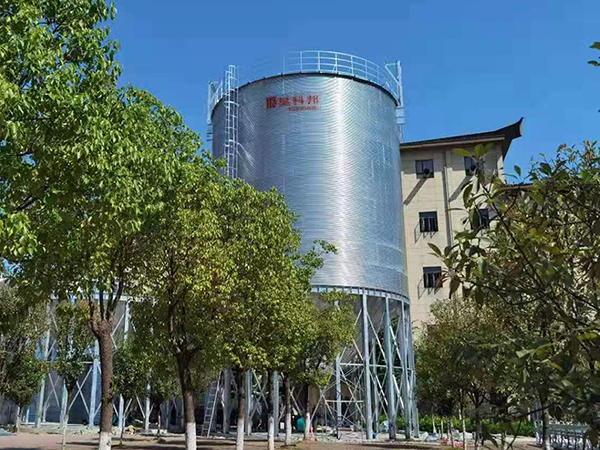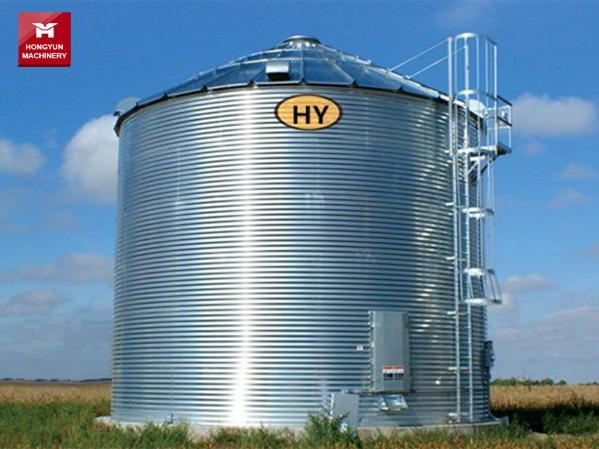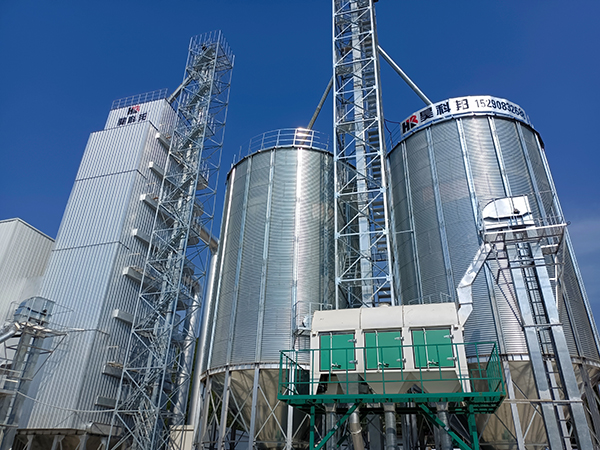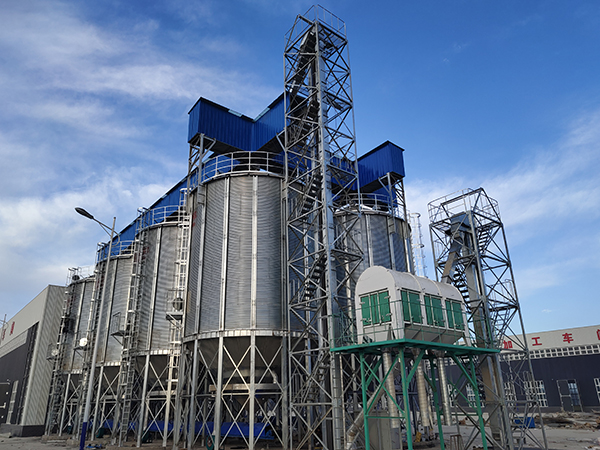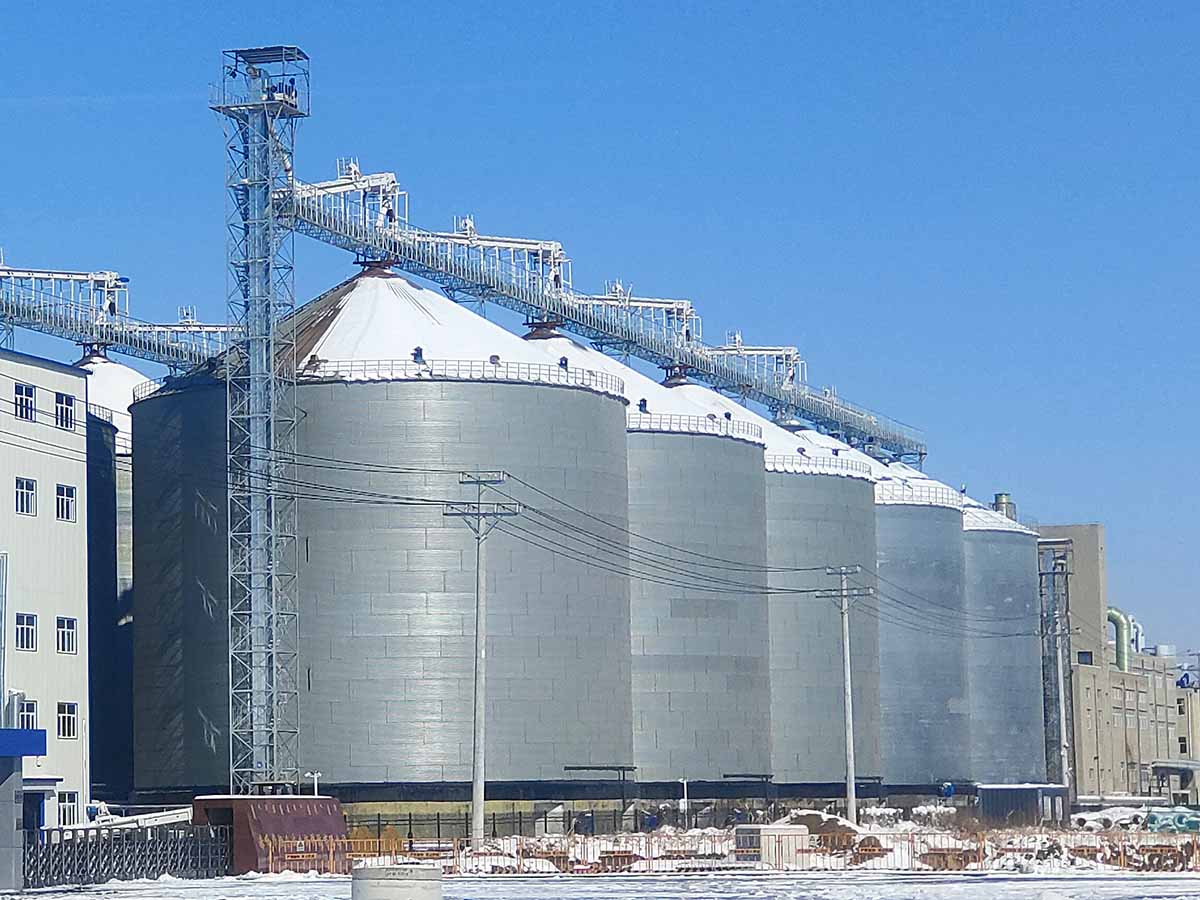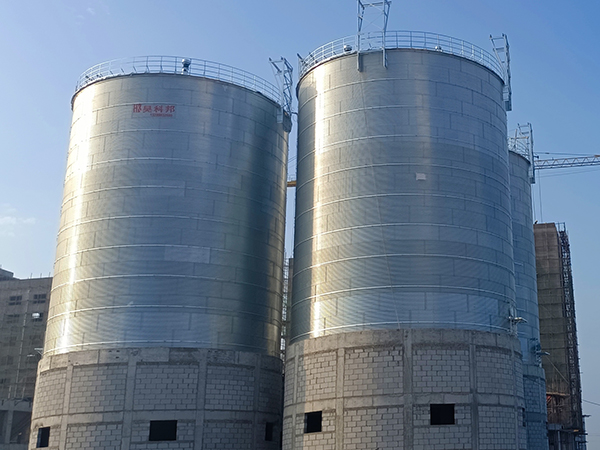Wheat cone bottom silo
The Wheat cone bottom silo is a conical-bottomed, prefabricated steel tube silo specifically designed for storing granular grains such as wheat.
Wheat cone bottom silo Introduction
The Wheat cone bottom silo is a conical-bottomed, prefabricated steel tube silo specifically designed for storing granular grains such as wheat. It is particularly suitable for the long-term storage and rapid unloading of wheat and other granular grains. With thoughtful design and high-quality materials, the conical bottom silo ensures the quality of wheat is maintained throughout the storage process, while enhancing the efficiency and safety of grain management.
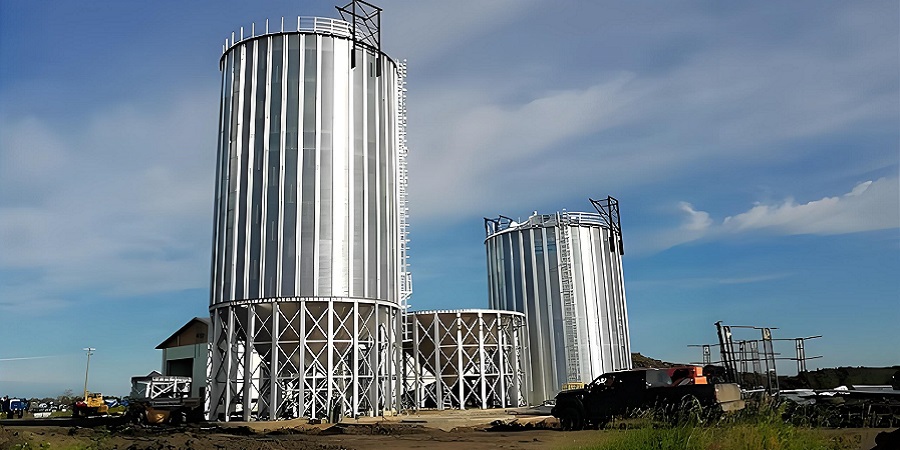
Main features of wheat cone bottom silo
Conical Bottom Design
Gravity Unloading:The conical shape of the bottom helps in utilizing gravity for automatic unloading, reducing the need for mechanical equipment and thereby lowering energy consumption and maintenance costs.
Even Flow:The conical design facilitates the even flow of grain, preventing long-term accumulation within the silo that could lead to clumping and mold growth.
Good Sealing Performance:
Pollution Prevention:Conical bottom silos usually feature a sealed design that effectively prevents external air, dust, and moisture from entering, keeping the grain dry and clean, and protecting it from mold and pests.
Fresh Storage:Good sealing performance helps maintain an optimal temperature and humidity environment within the silo, extending the freshness of the grain.
Material Selection
Durable Materials:Conical bottom silos commonly use high-strength, corrosion-resistant materials such as steel or galvanized sheets, which extend the silo’s service life and ensure the quality of the stored grain.
Smooth Inner Walls:The interior walls are typically designed to be very smooth, reducing grain adhesion, facilitating cleaning, and preventing pest infestations.
Temperature and Humidity Control:
Ventilation System:Conical bottom silos are usually equipped with ventilation systems to control air circulation, thereby adjusting the internal temperature and humidity to prevent the grain from becoming damp and spoiled.
Monitoring Equipment:Modern conical bottom silos often install temperature and humidity sensors and monitoring devices to continuously track the internal environment and adjust it through automated systems.
Convenient Operation:
Automated Management:Many conical bottom silos come with automated control systems that allow for remote monitoring and operation, significantly enhancing management efficiency and safety.
Easy Cleaning:The conical design makes it easier to clean residual grain from the silo, reducing the need for manual cleaning efforts.
Flexible Capacity
Various Specifications:Conical bottom silos are available in various specifications and sizes, allowing for customization based on specific needs and accommodating different scales of grain storage.
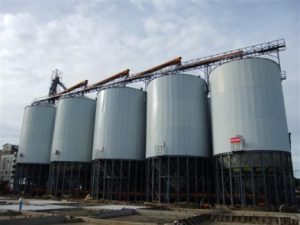

Main structure of wheat cone bottom silo
Silo Body
Main Structure: The silo body is usually cylindrical and made from high-strength, corrosion-resistant materials such as steel or galvanized sheets. The design is robust, capable of withstanding the weight and pressure of a large quantity of grain.
Inner Wall Design: The interior walls are designed to be smooth, reducing grain adhesion, facilitating cleaning, and preventing pest infestations.
Conical Bottom
Conical Bottom: The conical design helps utilize gravity for automatic unloading, ensuring even grain flow and preventing clumping and mold growth.
Discharge Outlet: Located at the lowest point of the conical bottom, it typically features control valves and discharge equipment for easy grain unloading.
Roof
Sealed Roof: The roof is usually sealed to prevent external contaminants such as rainwater and dust from entering the silo.
Ventilation Openings: The roof typically has ventilation openings to ensure air circulation inside the silo, preventing moisture and spoilage of the grain.
Support Structure
Support Legs: The conical bottom silo is usually mounted on support legs, which are designed to be sturdy and ensure the stability and safety of the entire silo.
Foundation: The foundation, where the support legs connect to the ground, is typically made of concrete or steel to provide stable support.
Ventilation System
Ventilation Ducts: The silo includes ventilation ducts to control air circulation, adjusting internal temperature and humidity to prevent the grain from becoming damp and spoiled.
Fan Equipment: Fans in the ventilation system promote air circulation, maintaining an optimal storage environment inside the silo.
Monitoring Equipment
Temperature and Humidity Sensors: Sensors installed inside the silo continuously monitor environmental parameters.
Automated Control System: Working with the monitoring equipment, the automated control system adjusts conditions to ensure a stable internal environment.
Discharge System
Control Valves: Installed at the discharge outlet, control valves manage the flow rate and speed of the grain being discharged.
Conveying Equipment: Equipment such as conveyor belts or screw conveyors transport the discharged grain to other locations.
Cleaning Port
Inspection and Cleaning Port: Designed for regular inspection and cleaning of residual grain, ensuring the hygiene and quality of the storage environment inside the silo.

Main structures of wheat cone bottom silo
Silo Body
Main Structure: The silo body is usually cylindrical and made from high-strength, corrosion-resistant materials such as steel or galvanized sheets. The design is robust, capable of withstanding the weight and pressure of a large quantity of grain.
Inner Wall Design: The interior walls are designed to be smooth, reducing grain adhesion, facilitating cleaning, and preventing pest infestations.
Conical Bottom
Conical Bottom: The conical design helps utilize gravity for automatic unloading, ensuring even grain flow and preventing clumping and mold growth.
Discharge Outlet: Located at the lowest point of the conical bottom, it typically features control valves and discharge equipment for easy grain unloading.
Roof
Sealed Roof: The roof is usually sealed to prevent external contaminants such as rainwater and dust from entering the silo.
Ventilation Openings: The roof typically has ventilation openings to ensure air circulation inside the silo, preventing moisture and spoilage of the grain.
Support Structure
Support Legs: The conical bottom silo is usually mounted on support legs, which are designed to be sturdy and ensure the stability and safety of the entire silo.
Foundation: The foundation, where the support legs connect to the ground, is typically made of concrete or steel to provide stable support.
Ventilation System
Ventilation Ducts: The silo includes ventilation ducts to control air circulation, adjusting internal temperature and humidity to prevent the grain from becoming damp and spoiled.
Fan Equipment: Fans in the ventilation system promote air circulation, maintaining an optimal storage environment inside the silo.
Monitoring Equipment
Temperature and Humidity Sensors: Sensors installed inside the silo continuously monitor environmental parameters.
Automated Control System: Working with the monitoring equipment, the automated control system adjusts conditions to ensure a stable internal environment.
Discharge System
Control Valves: Installed at the discharge outlet, control valves manage the flow rate and speed of the grain being discharged.
Conveying Equipment: Equipment such as conveyor belts or screw conveyors transport the discharged grain to other locations.
Cleaning Port
Inspection and Cleaning Port: Designed for regular inspection and cleaning of residual grain, ensuring the hygiene and quality of the storage environment inside the silo.
Application scope of wheat cone bottom silo
Coban Silo is widely used for grain storage such as wheat, corn, soybean, paddy, rice, soybean meal, barley, malt, sunflower seeds, rapeseed, peanuts, flour, and other powder materials, oat, special Silo, and seeds, etc.

Wheat cone bottom silo technical parameters
Scientifically speaking, the Silo capacity should be measured with volume (m3). Even in the same grain Silo, the storage tons will be different for different grains with different densities. The following table is calculated based on a Silo density of 0.75kg/m3, and surely HKB customizes Silo systems unique for you.
| Most Popular Hopper Bottom Steel Silo Technical Specifications | ||||||||
| Capacity | 50Ton | 100Ton | 150Ton | 200Ton | 300Ton | 500Ton | 1000Ton | 1500Ton |
| Model | TCZK
03605 |
TCZK
04507 |
TCZK
05507 |
TCZK
06406 |
TCZK
07307 |
TCZK
07313 |
TCZK
11010 |
TCZK
12811 |
| Diameter(m) | 3.667 | 4.584 | 5.500 | 6.417 | 7.334 | 7.334 | 11.000 | 12.834 |
| Total Height(m) | 9.56 | 12.53 | 13.25 | 12.85 | 14.70 | 21.42 | 20.95 | 23.51 |
| Volume(m³)
Density:0.75ton/m³ |
69 | 150 | 222 | 273 | 415 | 699 | 1346 | 2039 |
| Most Popular Flat Bottom Steel Silo Technical Specifications | ||||||||
| Capacity | 1000Ton | 1500Ton | 2000Ton | 2500Ton | 3000Ton | 5000Ton | 8000Ton | 10000Ton |
| Model | TCK
10014 |
TCK
11915 |
TCK
13715 |
TCK
15514 |
TCK
15518 |
TCK
18321 |
TCK
24718 |
TCK
25621 |
| Diameter(m) | 10.084 | 11.918 | 13.750 | 15.584 | 15.584 | 18.334 | 24.751 | 25.668 |
| Total Height(m) | 18.69 | 20.34 | 20.87 | 20.30 | 24.78 | 28.60 | 26.99 | 30.60 |
| Volume(m³)
Density: 0.75ton/m³ |
1335 | 2009 | 2701 | 2467 | 4145 | 6693 | 10879 | 13484 |
After-sale Service
- – HKB provides advanced grain safety storage technology to assure your grain silo 100% quality stability.
- – grain silo Quality guarantee is one year after installation and commissioning or 18 months after leaving China Port. Maturity is the first.
- – 7 days x 24 hours service, within 24 hours reply/solve of any technical issues upon request.
- – Routinely telephone track to remove all might be problems grain silo or issues guarantying the whole system grain silo long-lasting safety and reliability.
- – HKB will consider all other needs like customs clearance, sea delivery, insurance, customs tax benefit plan, documentation, etc. So our respected Users feel so relaxed and easy to get the grain silo system well.

